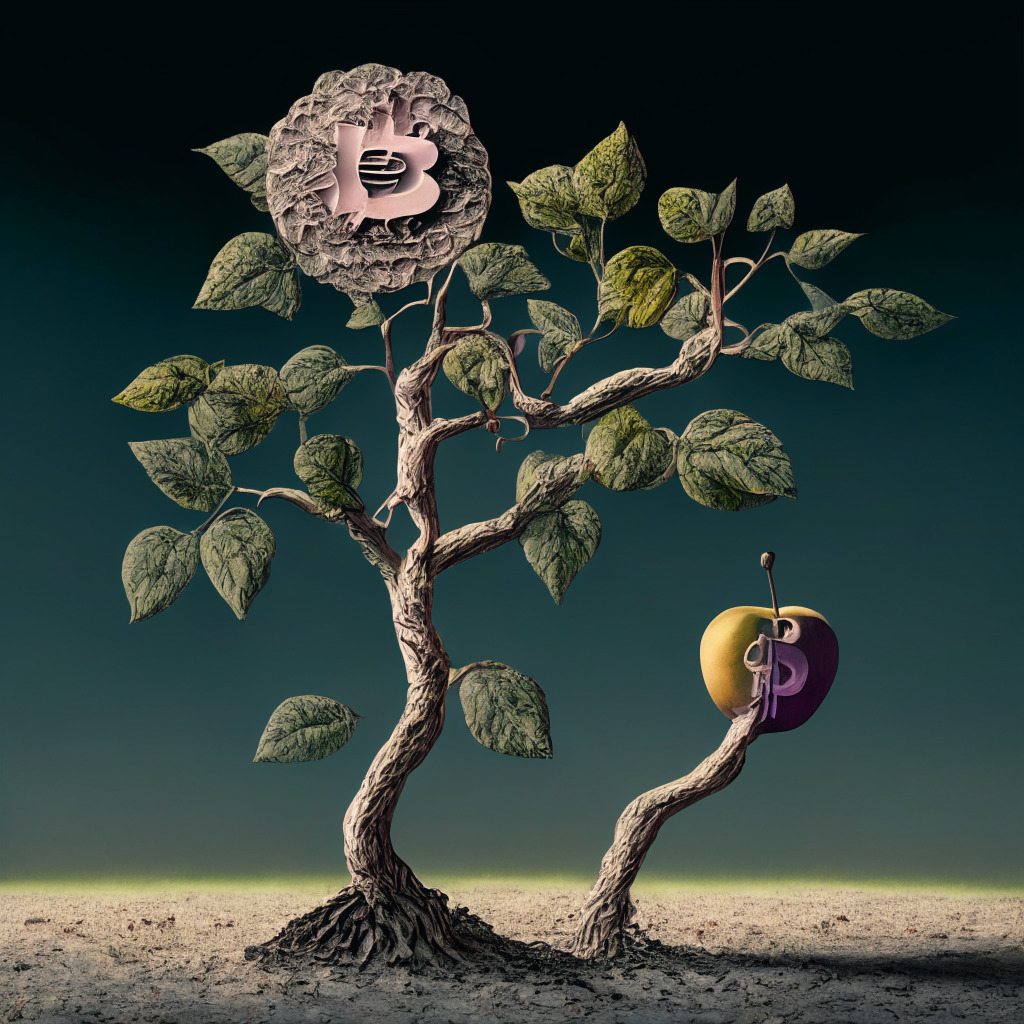“This week in blockchain featured a focus on tokenisation of real-world assets, a promising industry potentially worth $5 trillion. However, concerns of standardisation in finance could hinder growth. Ralf Kubli, Casper Association board member, advocates for better quality and transparency of information in financial asset tokenisation to avoid replicating conditions that led to the Great Financial Crisis. “
Search Results for: Spark Protocol
Stablecoin Surge: Circle CEO Advocates for Digital Money Revolution and Its Impacts on Global Economy
Jeremy Allaire, CEO of Circle, highlights the need for fast progression of digital dollar and stablecoin development to preserve the vitality of the US dollar. In context of rising crypto adoption, he implies digital currencies potentially shaping future global commerce and payment protocols.
Navigating India’s Updated Data Protection Bill: BigTech’s Freedom vs Public Trust
India’s parliament has approved an update to the Digital Personal Data Protection Bill 2023, easing data compliance for tech giants. The Bill regulates data exports, with provisions for less stringent regulations on data storage, processing, and transfer. However, it’s still a topic of debate, as it potentially prioritizes tech advancement over robust data security.
Bounty Hunting in Crypto Space: Examining the $1.85M Offer from Curve Finance
“Decentralized finance platform, Curve Finance is offering a $1.85 million bounty for identifying the culprit who drained $61 million from its stable pools. These incidents expose the vulnerabilities within DeFi projects, undermining the perception of security and trust, and emphasize the need for a balance between innovation and security.”
Decentralized Finance: Far from Dead or a Doomed Experiment?
“Despite setbacks and criticisms, such as the recent Curve Finance controversy, the DeFi sector is far from ‘dead.’ It’s actually seeing significant interest from corporate stalwarts like Mastercard, Visa, and BlackRock, all harnessing its efficiency-enhancing capabilities. Decentralized finance technology promises transparency, efficiency, disintermediation, and self-custody, indicating the sector’s potential for long-term growth.”
DeFi Security Scare: The $61 Million Curve Finance Breach Study
A recent exploit targeting the Curve Finance pools via the Vyper programming language led to a $61 million theft, exposing DeFi vulnerabilities. This event has sparked discussions about security in the blockchain era and emphasized the need for continuous investment in safety protocols. Despite losses, it also presents an opportunity for DeFi platforms to refine and rebuild.
Crypto Solidarity: Understanding Justin Sun’s Rescue of Curve Finance from Looming Crisis
In an effort to save the decentralized exchange protocol, Curve Finance, from a potential bad debt crisis, crypto investor Justin Sun purchased approximately 5 million Curve tokens. Sun’s actions helped preserve the value of CRV tokens and demonstrated the potential of collective action in protecting investments amid the volatile nature of the cryptocurrency market.
Advancing Bitcoin Payments: The Future of Lightning Network and Its Impact on Crypto Exchanges
“Influential figures discuss the potential of Bitcoin’s Lightning Network (L2). CEO of Coinbase, Brian Armstrong, shares ventures for incorporating L2 into their platforms, enhancing Bitcoin scalability, security, and transaction speed. L2 promises profound benefits such as low-cost transactions, faster payment settlements, and user anonymity.”
Worldcoin’s Controversial Iris-Scan Tech: Blockchain Innovation or Privacy Nightmare?
“Worldcoin, a crypto protocol that uses iris scans for global identification, has been halted in Kenya due to concerns over data protection. This raises questions on privacy and potential user exploitation in the name of innovation, sparking investigations beyond Kenya’s borders. The crypto community closely watches this as it could define the future of blockchain technology.”
Risk-Reward Playground: Egorov’s DeFi Debt Saga and The Unorthodox Approach of Selling CRV Tokens
Curve founder, Michael Egorov, is exploring unexpected avenues to manage his crumbling DeFi loans. Egorov sold off CRV tokens below market rate to individuals with notorious reputations causing concerns. Despite paying off substantial debts, a large financial obligation remains, spotlighting the high-risk DeFi world and potential drastic actions in disastrous financial situations.
The Rise and Crisis of DeFi: A Close Brush with Disaster and Its Implications
“The DeFi community recently faced a potential crisis when Curve Finance’s founder risked significant funds on his platform’s tokens. This precarious scenario could have toppled the entire DeFi sector. The incident has sparked questions about the system’s integrity, transparency, and overall stability, reminding us of the inherent risks of the rapidly evolving DeFi world.”
Decoding Term Finance: Navigating Loan Volatility in the DeFi Landscape
“Term Finance, gaining traction in the decentralized finance (DeFi) realm, offers short-term, fixed-interest rate loans on the Ethereum mainnet. This innovative model provides a solution to variable-rate crypto loans’ unpredictability, with assurances for borrowers and lenders through a weekly auction model.”
Unraveling the Mystery of Zero-Knowledge Proofs: A Double-Edged Sword in Crypto Privacy
“Zero-knowledge proofs (ZK-proofs), cryptographic protocols that authenticate transactions without disclosing specifics or user identities, play a significant role in improving the privacy and scalability of cryptocurrency transactions. However, aspects like verifying protocol, potential security flaws and facilitating illegal activity present challenges to their wide adoption.”
Vyper Language Vulnerability Alarms DeFi Space: Pitfalls and Lessons Learned
“A vulnerability in the Vyper programming language led to several DeFi exploits, highlighting the potential risks of the sector. However, the incident has underscored the importance of rigorous smart contract auditing and proactive security measures, ensuring the DeFi ecosystem’s future resilience.”
Worldcoin’s Proof of Security Amid Biometric Criticism: A Necessary Evil or Orwellian Nightmare?
“Worldcoin, known for its proof of humanity protocol, faced criticism over data collection practices. Post security audits by Nethermind and Least Authority, 24 out of 26 identified issues were resolved. Unaddressed issues remain a concern despite progress in addressing challenges for this biometric security and blockchain blend.”
Balancing Act: Decentralization, Mining Centralization, and the Future of Blockchain Technology
“This article explores the potential pitfalls of Bitcoin’s proof-of-work system, highlighting mining centralization and the economic imbalance it can cause. It encourages a shift towards alternative consensus mechanisms to align incentives between miners and users, maintaining blockchain’s promise of financial democracy.”
Unmasking Worldcoin: The Juxtaposition of Privacy, Centralization, and Digital Identity
“The launch of Worldcoin, a blockchain platform promising identity privacy through an iris scan, is sparking debate around privacy, centralization, and global identity. Critics argue the project’s centralization and handling of sensitive data presents substantial risk. As blockchain evolves, grappling with these issues will intensify.”
Ethereum’s Vitalik Buterin Deliberates Over Human Identity Verification Systems and their Role in Blockchain Security
Ethereum Co-founder Vitalik Buterin responds to Worldcoin’s launch of a decentralized human identity verification system, viewing it as integral in tackling online spam and power centralization. Buterin also stresses the need for privacy, accessibility, transparency, and security in such identity solutions to prevent wealth concentration in potentially hostile hands. Despite potential threats to privacy and system security, Buterin promotes hybrid approaches to proof of personhood, warning of a future intertwined with AI and the need for careful blockchain navigation.
Navigating the Crypto Terrain: The Surge of Maker (MKR) and the Risk and Reward of Meme Coins
“The Maker protocol introduced a token buy-back scheme, aiming to repurchase approximately $7 million worth of MKR over the coming month, creating market enthusiasm. However, conditions indicate possible overbuying, advising market caution. Despite this, optimism remains in the cryptocurrency’s healthy chart setup.”
The Chainlink Boom and the Role of CCIP: Whales, Oracles, and Cross-Chain Applications
Following Chainlink’s Cross-Chain Interoperability Protocol (CCIP) release, LINK experienced a surge due to increased interest from large investors. CCIP, a key initiative aimed at improving cross-chain services and applications, is now live on multiple blockchains, positioning Chainlink as a prominent player in the growing blockchain technology industry.
The Strategy and Impact of Token Burns: BNB Chain’s 24th Burn Event.
“The Blockchain BNB Chain recently incinerated over 1.99 million BNB tokens, aligning with the ‘auto-burn’ protocol, and diminishing $484 million worth of tokens from circulation. Token burn aims to stimulate scarcity by permanently reducing the circulating supply. However, such events do not always stimulate immediate market demand, posing questions about the real-time effectiveness of these strategies.”
Harnessing the Future: zkSync’s Boojum and the Transformation of the Crypto-Landscape
zkSync Era’s latest launch, a STARK-based proof system called Boojum, aims to increase capacity while reducing fees in the Ethereum scaling protocols landscape. The system offers significant scalability and transparency improvements and promises superior processing capabilities. It seeks to make cryptosystems more accessible, potentially initiating a transformative shift in blockchain technology towards mass usability.
A Deep Dive into Cryptocurrency Rewards: MarginFi’s Successful Strategy & Future Challenges
Cryptocurrency platform MarginFi operates on the Solana blockchain and uses a points-based rewards program to engage users, with rewards potentially transitioning into tokens. The systems encourage user participation in protocol operations, aligning with the decentralized ethos of crypto. However, as tokens under management increase, concerns over ecosystem liquidity threshold arise.
Ethereum Staking Landslides: How Stader Labs is Balancing the Scales
Stader Labs, a non-custodial multi-chain liquid staking platform, has expanded to Ethereum, offering superior yields on ETH staking. The platform has significantly reduced the capital commitment for node operators, promising a return rate exceeding 6%. Additionally, they aim to tackle the issue of centralization with a self-limit on their share of all ETH staked.
Celsius Vs StakeHound: A $150 Million Crypto Controversy Unravelled
Celsius, a bankrupt crypto lender, is suing StakeHound for allegedly failing to return tokens valued over $150 million. StakeHound argues they have “no obligation” to exchange proprietary stTokens or return lost Celsius ETH keys. This dispute highlights how navigating regulatory frameworks like the U.S. Bankruptcy Code can be complex in the crypto world.
Exploiting the Exploitable: The $9M DeFi Heist that Shook Up Solana
A former security engineer exploited a vulnerability in a Solana-based crypto exchange, causing $9 million in damages. This first-ever case highlights smart contract bugs’ potential for misuse, and sparks questions about DeFi risks. It compels a thorough examination of system security in preventing inside attacks, and emphasizes the need for stringent measures. It’s a test for blockchain technology’s promise of secure, decentralized financial systems.
Ethereum Staking Approaches Turning Point: Regulatory Pitfalls vs Potential Yields
“Almost 20% of all Ether tokens are now locked in staking contracts, signaling a significant turning point. However, initial inflows have slowed, perhaps due to investors’ concern about potential regulatory issues. The U.S. Securities and Exchange Commission’s lawsuits against major ETH staking service providers have led to a drop in net inflow into ETH staking.”
Battle of Titans: Apple vs Bitcoin-Friendly Damus – Unpacking a Modern David and Goliath Saga
The social media app Damus, popular for its Bitcoin-friendly features, recently faced potential removal from Apple’s App Store due to its Bitcoin tipping feature. The issue sparked concerns over curbing Bitcoin adoption and the evolution of global payment protocols over the internet. However, the confrontation gave rise to the Zapple Pay, a workaround bypassing Apple’s restrictions, highlighting the resilience of BTC-friendly platforms.
Decentralized Social Media: Empowering Users or Opening Pandora’s Box?
“DeSo is a decentralized social media system built on blockchain technology, aiming to counteract issues with traditional social media platforms. By keeping user identities, content, and networks on-chain, DeSo proposes a platform where content ownership mirrors Bitcoin’s security. However, such systems can often lack moderation, potentially leading to cyberbullying, misinformation, or misuse.”
Decoding the Crypto-Conflict Landscape: Asset Loans, DeFi Security, and Green Mining
Bitget introduces Crypto Loans, allowing users to stake their coin as collateral and borrow in another cryptocurrency, based on market value. As potential pitfalls exist in case of market plunges, the Ethereum community visionaries propose a Circuit Breaker contract for DeFi protocols’ security enhancement, albeit with implementation and manipulation concerns.
Navigating the Crypto Seas: Interpretations of Recent Market Fluctuations and Insight into ETF Filings
“Cryptocurrencies maintain gains with Bitcoin above $31,000 and Ethereum around $1960. DeFi tokens like Compound and MakerDAO show remarkable growth. Amidst regulatory uncertainties like the delayed Bitcoin ETF filing by BlackRock, the market showcases resilience but highlights the ecosystem’s volatility and need for transparency and prompt information update.”
The SEC’s Stance on Bitcoin ETF: A Wake-up Call or Unnecessary Skepticism?
The U.S. SEC expressed concerns about the robustness of filings for a Bitcoin ETF, causing a $1,000 dip in Bitcoin price. This has sparked ambiguity and concerns among crypto-enthusiasts about the readiness of financial institutions to embrace Bitcoin.































